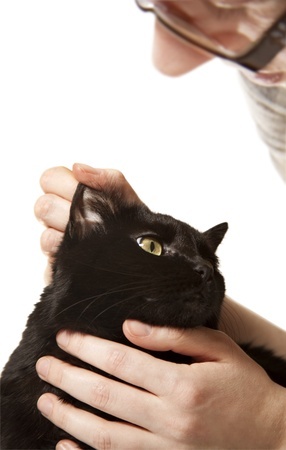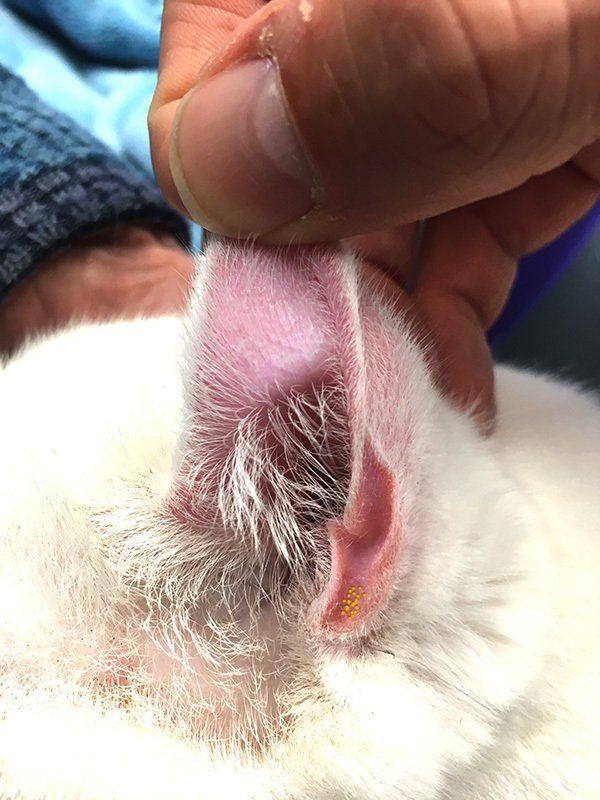The six legged harvest mite larva feeds on tissue fluid and may cause considerable itching and discomfort to both dogs and cats. Although there are some clear symptoms a harvest mite infestation can only be diagnosed and treated by a vet.
In the fur the ballpoint pen dot is large.

Autumn harvest mite cats. Harvest mites or chiggers are seasonal parasites seen mainly in the autumn time a habit which gives them their name Neotrombicula autumnalis. Harvest mites are spall parasitic mites with the Latin name of Trombicula autumnalis which go through a life cycle of egg larvae nymph and adult. However there are steps you can take to prevent your pet suffering from unnecessary itching or scratching.
Selamectin applied to the skin of the nape of the neck is absorbed by the blood capillaries and reaches optimum. In cats harvest mites are most commonly found around the ears and between the toes but can be found almost anywhere on the body. Harvest mites--also called harvest bugs bracken bugs or chiggers--are a form a parasitic insect that can cause severe skin irritation in cats.
The larvae of harvest mites can cause seasonal skin challenges for dogs and cats particularly during late summer and autumn. There are approximately 10000 species of chiggers and their distribution is worldwide. The larval stage when it has six legs is the only stage which attacks warm blooded animals.
It would appear they are a bigger issue for cats in the United States most commonly called chiggers or red bug and Europe where they are known as harvest. It is the larval stages that actually affect our pets and these can be seen by the human eye as small. Because the Harvest Mites cause such intense itching you will notice your pet continually scratching biting or rubbing itself against objects to get some relief for its skin.
She received her Doctor of Veterinary Medicine from the University of Minnesota in 1998. Harvest mites live in rural areas and cats can easily pick up this parasite while out exploring especially in chalky areas. They mainly infest mice but also dogs domestic cats humans and other mammals.
The mite larvae are one to two millimetres in size - easy to recognise by small orange dots eg. HARVEST MITES The larvae of harvest mites can cause seasonal skin challenges for dogs and cats particularly during late summer and autumn. Harvest mites Neotrombicular autumnalis are a strange external parasite that can affect dogs and cats and usually only at this time of yearThe name Harvest Mite has come about due to the short season that they seem to appear for is usually around or just after the typical harvest.
The harvest mite is a small orange coloured mite that can cause skin irritation of dogs cats and other animals. Harvest Mite Infestation in Cats. If this is the case your feline friend is infected with mites and we must take urgent measures to eradicate this disease.
The mite is particularly abundant in chalky areas and gardens where soft fruit is grown. The harvest mite Trombicula autumnalis is a tiny mite the larval stage of which causes considerable discomfort to cats and dogs during the late summer and autumn. Chigger mites are also known as harvest mites.
Harvest mites harvest bugs or bracken bugs are the names popularly given to the larvae of the mite Trombicula autumnalis. The scratching can cause hair loss and skin irritation and in. The adult mite is an eight-legged mite that lives in vegetation but the six-legged larvae are parasitic and live on mammals including humans and cats and birds.
Additionally there are some helpful steps you can take to help your cat recover and heal from a harvest mite infestation. Mites will die while feeding. There are several mite species that may annoy animals and humans directly especially during the late summer and autumn.
They tend to be found in areas of grassland and cornfields. They are most prevalent between spring and autumn when conditions are hot and humid. As you are.
Harvest mites or chiggers are seasonal parasites seen mainly in the autumn time a habit which gives them their name Neotrombicula autumnalis. Harvest mites live in rural areas and cats can easily pick up this parasite while out exploring especially in chalky areas. One of several mite species which can annoy our four-legged friends during late summer and early autumn the harvest mite tends to be found on grassy areas or in cornfields.
The large orangeyellow larvae are widely distributed throughout the UK. Mites usually feed for around 2-3 days before dropping off but the itching can last for several weeks. The autumn grass mite larvae feeds on a mixture of saliva secretion and cell fluid of the uppermost skin layers.
Their larvae have various local names such as harvest mites harvest bugs harvesters berry bugs bracken bugs chiggers and in Ireland orange. It is the larvae stage of the life cycle that can cause a problem for dogs and harvest mites during the other stages.

Harvest Mites How To Prevent Them Argos Pet Insurance
Neotrombicula Autumnalis In Cats Vetlexicon Felis From Vetlexicon Definitive Veterinary Intelligence
Neotrombicula Autumnalis In Cats Vetlexicon Felis From Vetlexicon Definitive Veterinary Intelligence

Harvest Mite Infestation In Cats International Cat Care

Harvest Mite Infestation In Cats International Cat Care

Blog Fall Breeze And Autumn Leaves Blog Vita Canis Mites On Dogs Dog Allergies Dog Dry Skin

How To Get Rid Of Harvest Mite Infestations In Cats 10 Steps

How To Get Rid Of Harvest Mite Infestations In Cats 10 Steps

How To Get Rid Of Harvest Mite Infestations In Cats 10 Steps

Cat Mite Advice Care Vets4pets

Harvest Mite Infestation In Cats International Cat Care

Image Result For Harvest Mites On Dogs Fleas Mites On Dogs Dogs

How To Get Rid Of Harvest Mite Infestations In Cats 10 Steps

Harvest Mite Infestations In Cats Vca Animal Hospital

How To Get Rid Of Harvest Mite Infestations In Cats 10 Steps

Black Cat Hair Fur For Spell Work Witchcraft And Other Etsy In 2021 Custom Cat Cat Fur Cats

Feline Trombiculosis A Retrospective Study In 72 Cats Leone 2013 Veterinary Dermatology Wiley Online Library



